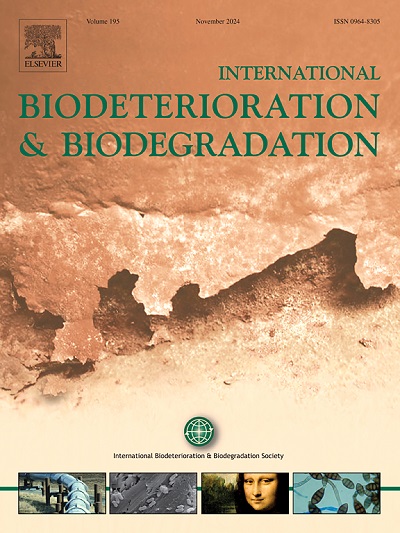探索高Cr(VI)还原性菌株Alcaligenes faecalis S1和耐Cr(VI)菌株大环内酯溶杆菌S2去除Cr(VI)的协同相互作用:基因组和机制见解
IF 4.1
2区 环境科学与生态学
Q2 BIOTECHNOLOGY & APPLIED MICROBIOLOGY
International Biodeterioration & Biodegradation
Pub Date : 2025-08-06
DOI:10.1016/j.ibiod.2025.106185
引用次数: 0
摘要
六价铬[Cr(Ⅵ)]对公共健康和生态安全构成严重威胁,而将Cr(Ⅵ)生物还原为三价铬[Cr(Ⅲ)]对环境的风险要小得多。本研究考察了还原能力强的Alcaligenes faecalis S1和对Cr(VI)具有耐受性的Lysinibacillus macrolides S2对Cr(VI)的去除性能和机制。结果表明,菌株S1和S2的细胞外分泌物是Cr(VI)还原的主要部位,主要以六价铬胞外还原为三价铬的形式进行。细菌的基因组发现证实了这一观点,因为菌株S1和S2都具有铬酸盐还原基因,同时显示出铬酸盐转运蛋白和DNA修复蛋白酶等在降低Cr(VI)对自身的毒性中起作用。为了进一步研究菌株S1和S2对Cr(VI)的协同耐药机制,我们进一步构建了细菌联合体S3。结果发现,S1和S2通过表达还原和抗性基因,协同增强细菌联合体S3对Cr(VI)的抗性,使其具有更广泛的pH适应性和优异的Cr(VI)还原能力。这种互补作用使得S3具有多种生物还原机制:酶介导的Cr(VI)还原、dna修复酶、解毒酶和Cr(VI)外排,显著降低Cr(VI)毒性损伤。综上所述,本研究加深了对菌株S1和S2的基本特性以及Cr(VI)的修复协同机制的认识,为今后的生物修复提供了分子基础和科学指导。本文章由计算机程序翻译,如有差异,请以英文原文为准。

Exploring synergistic interactions in Cr(VI) removal by highly Cr(VI)-reductive strain Alcaligenes faecalis S1 and Cr(VI)-tolerant strain Lysinibacillus macrolides S2: genomic and mechanistic insights
Public health and ecological security are seriously threatened by hexavalent chromium [Cr(Ⅵ)], whereas bioreduction of Cr(Ⅵ) to trivalent chromium [Cr(Ⅲ)] presents a far lesser risk to the environment. The study examined the performance and removal mechanisms of Cr(VI) by Alcaligenes faecalis S1, known for its strong reducing capacity, and Lysinibacillus macrolides S2, which shows tolerance to Cr(VI). The results indicated that the extracellular secretions of strains S1 and S2 were the main sites of Cr(VI) reduction, primarily in the form of extracellular reduction of hexavalent chromium to trivalent chromium. The genomic findings of bacteria substantiated this idea, as both strains S1 and S2 possessed chromate reduction genes, concurrently demonstrating chromate transporter proteins and DNA repair proteases, among others, that function in reducing Cr(VI) toxicity to themselves. The construction of bacterial consortium S3 was further pursued in order to investigate the synergistic resistance mechanism of strains S1 and S2 against Cr(VI). It was found that S1 and S2 synergistically enhance the Cr(VI) resistance of the bacterial consortium S3 through the expression of reduction and resistance genes, endowing it with broader pH adaptability and excellent Cr(VI) reduction capabilities. This complementary effect allowed S3 to have multiple biological reduction mechanisms: enzyme-mediated reduction of Cr(VI), DNA-repaired enzymes, detoxification enzymes, and Cr(VI) efflux, significantly reducing Cr(VI) toxicity damage. In conclusion, this study has deepened the understanding of the fundamental characteristics of strains S1 and S2, as well as the remediation synergistic mechanisms of Cr(VI), providing a molecular basis and scientific guidance for future bioremediation.
求助全文
通过发布文献求助,成功后即可免费获取论文全文。
去求助
来源期刊
CiteScore
9.60
自引率
10.40%
发文量
107
审稿时长
21 days
期刊介绍:
International Biodeterioration and Biodegradation publishes original research papers and reviews on the biological causes of deterioration or degradation.

 求助内容:
求助内容: 应助结果提醒方式:
应助结果提醒方式:


